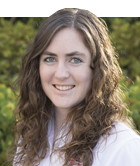For a good part of my childhood and most of my high school and college years, I have been the employee at my parents' 150-cow dairy in Valley Center, Kan. Like most farm children, I headed up calf care. I learned a few things along the calf panel south of the house, and none were more important than the need to modify protocol as technology improves and research continues to shed light on calf raising.
Our calves are housed on sand in traditional calf hutches. Each hutch has a metal cattle panel that allows the calf to move outside the hutch. The hutches face the south, and a relentless Kansas wind keeps the calves cool during hot summer months. We vaccinate and wean the calves before moving them to group housing around 3 months of age.
Because our calves had not been getting ill, we had continued our normal routine. However, last summer we paid the price for our dated calf-rearing protocols. We started losing calves to mysterious diseases. They would be eating fine one day, and by the evening of the following day, they would be dead. This didn't happen all too many times before my dad was on the phone with our vet asking for his assistance.
The problem turned out to be an infestation of pathogens in the calves' environment. Our calves, worn down by the heat of the summer and mild cases of dehydration, were succumbing to diseases that they normally would ward off without veterinary intervention. Because of the close proximity of our hutches to each other, the infection spread rapidly through almost all 40 calves.
Our calf feeding and care program, which had not been updated since the 1980s, received a complete overhaul . . . as did our facilities. Since last summer, we have replaced our sand with rock to reduce the breeding ground for pathogens. We have purchased a pasteurizer and raised the amount fed to the calves from 4 to 6 quart of milk per day while also focusing on administering adequate amounts of colostrum within the first 12 hours.
Additionally, we have added a cleaning regiment for our hutches by power-washing them between occupants. Working with our vet, we updated our vaccination plan and treatment protocol.
The solution to our calf problem was not a single change, and it was not a quick fix. It has been in the last several months that we have finally returned to a stable environment for our calves. The trap we fell into was one of tradition and comfort, but just because something has worked forever doesn't mean it always will.

The author is the 26th Hoard's Dairyman editorial intern. This fall she will be a senior at Kansas State University in Manhattan, Kan. At KSU, Maggie is double majoring in agricultural communications and journalism and animal sciences and industry. Seiler grew up on a 150-cow registered Holstein dairy in Valley Center, Kan., near Wichita.
Our calves are housed on sand in traditional calf hutches. Each hutch has a metal cattle panel that allows the calf to move outside the hutch. The hutches face the south, and a relentless Kansas wind keeps the calves cool during hot summer months. We vaccinate and wean the calves before moving them to group housing around 3 months of age.
Because our calves had not been getting ill, we had continued our normal routine. However, last summer we paid the price for our dated calf-rearing protocols. We started losing calves to mysterious diseases. They would be eating fine one day, and by the evening of the following day, they would be dead. This didn't happen all too many times before my dad was on the phone with our vet asking for his assistance.
The problem turned out to be an infestation of pathogens in the calves' environment. Our calves, worn down by the heat of the summer and mild cases of dehydration, were succumbing to diseases that they normally would ward off without veterinary intervention. Because of the close proximity of our hutches to each other, the infection spread rapidly through almost all 40 calves.
Our calf feeding and care program, which had not been updated since the 1980s, received a complete overhaul . . . as did our facilities. Since last summer, we have replaced our sand with rock to reduce the breeding ground for pathogens. We have purchased a pasteurizer and raised the amount fed to the calves from 4 to 6 quart of milk per day while also focusing on administering adequate amounts of colostrum within the first 12 hours.
Additionally, we have added a cleaning regiment for our hutches by power-washing them between occupants. Working with our vet, we updated our vaccination plan and treatment protocol.
The solution to our calf problem was not a single change, and it was not a quick fix. It has been in the last several months that we have finally returned to a stable environment for our calves. The trap we fell into was one of tradition and comfort, but just because something has worked forever doesn't mean it always will.

The author is the 26th Hoard's Dairyman editorial intern. This fall she will be a senior at Kansas State University in Manhattan, Kan. At KSU, Maggie is double majoring in agricultural communications and journalism and animal sciences and industry. Seiler grew up on a 150-cow registered Holstein dairy in Valley Center, Kan., near Wichita.








